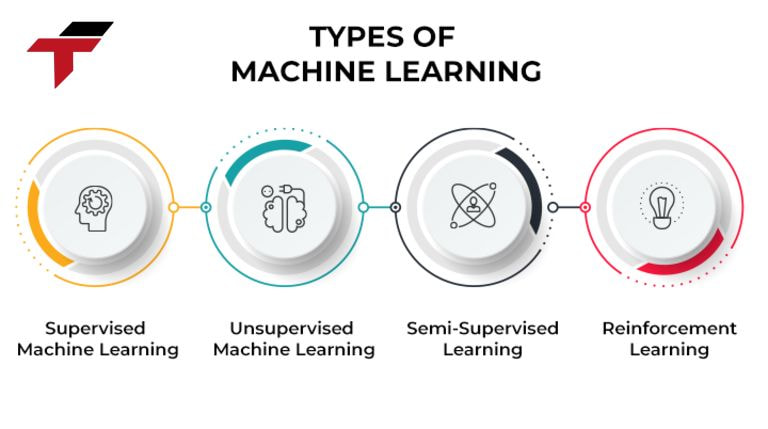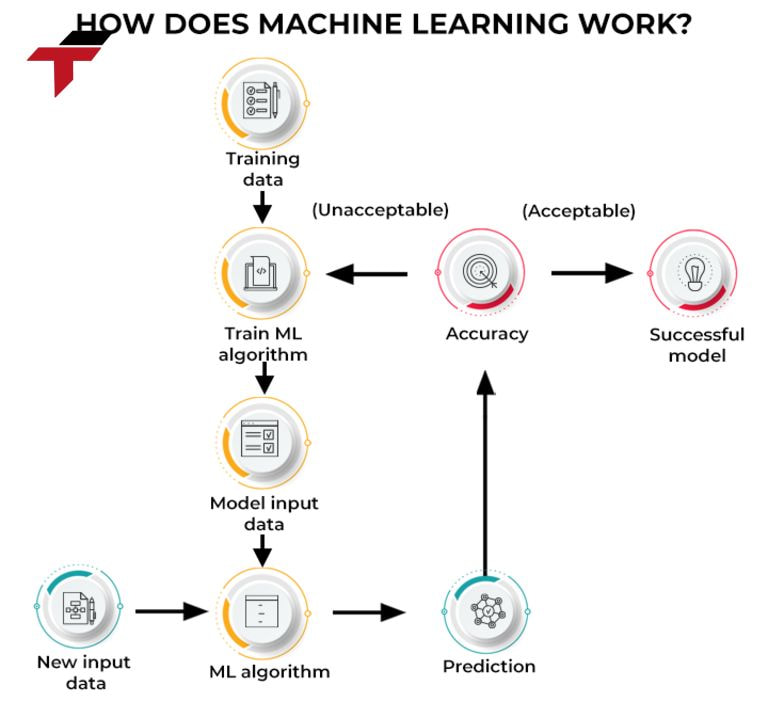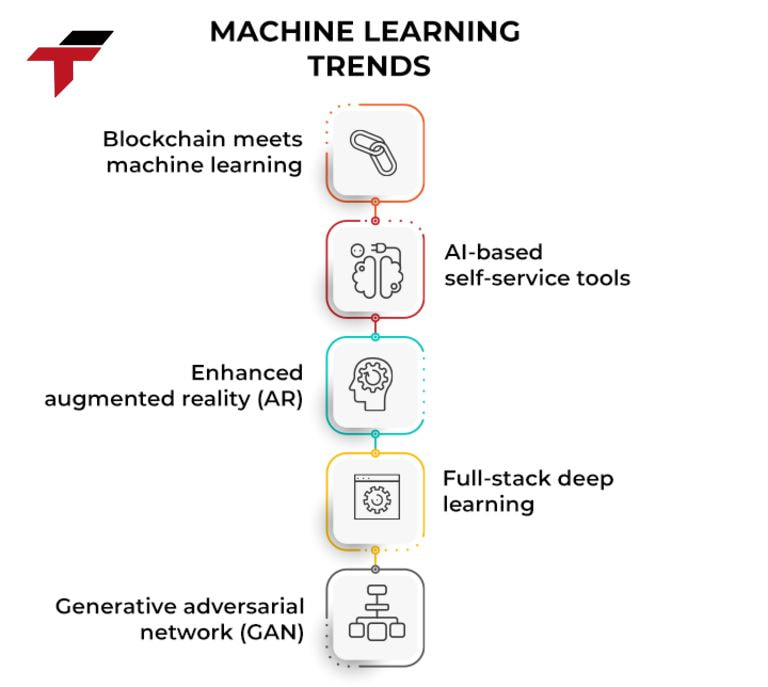Machine learning (ML) is a branch of artificial intelligence (AI) that allows machines to learn and improve their ability to perform tasks through experience and data. The process of machine learning involves feeding a machine with large amounts of data (e.g. images, text, numbers), and then the machine uses complex algorithms to find hidden patterns in that data. Based on these patterns, the machine can make predictions, classify, or generate new content.
How are ML and AI different?
Machine learning (ML) and AI are two methods commonly used in many automated manufacturing processes. However, these two methods also have distinct characteristics as follows:
| Feature | Artificial Intelligence (AI) | Machine Learning (ML) |
| Approach | Use logic, decision trees, and other techniques to make decisions, reason, and self-correct. | Use self-learning algorithms to build predictive models and improve from data. |
| Scope of application | Covering many areas such as natural language processing, robotics, and decision-making. | Focusing on specific tasks such as image recognition, and data analysis. |
| Input data | Work with all types of data: structured, semi-structured, and unstructured. | Usually only uses structured and semi-structured data. |
| Self-learning ability | Integrates multiple technologies for self-learning and optimization. | Focus on self-study to complete a single task. |
| Target | Build systems that simulate human intelligence to perform complex tasks. | Build systems that learn from data to perform specific tasks with highly accurate results. |
What types of Machine Learning are there?

What types of Machine Learning are there?
Machine Learning and AI are two technologies that have greatly contributed to many areas of life today. In particular, Machine Learning (ML) has a fairly good coverage because it has a wide variety of classifications with separate applications, specifically divided into five main categories as follows:
Supervised Machine Learning
- Characteristics: Trained on labeled data.
- Applications: Weather forecasting, image recognition, fraud detection.
Typical algorithms:
- Classification: Classify data (e.g. “spam” or “not spam”).
Unsupervised Machine Learning
- Characteristics: Works with unlabeled data.
- Applications: Used for customer segmentation, and anomaly detection in systems.
Self-Supervised Machine Learning
- Characteristics: Automatically generates labels from unlabeled data.
- Applications: Often used for natural language processing (NLP), and computer vision.
- Benefits: Saves the cost of labeling large datasets.
Reinforcement Machine Learning
- Characteristics: Agents learn through reward/punishment systems.
- Applications: This classification is commonly used for game development and robot programming.
- Mechanism: Iterative learning to optimize strategies.
Semi-Supervised Machine Learning
- Characteristics: Combines labeled and unlabeled data.
- Applications: Used in automatic labeling processes, generating synthetic data.
- Representative algorithm: Generative Adversarial Network (GAN).
How does Machine Learning work?

How does Machine Learning work?
Machine Learning is a field in artificial intelligence (AI) that helps computers monitor and improve all data without being directly programmed, the principle of operation through the following steps:
- Training data: Collect and input data into the algorithm. This data can be known (labeled) or unknown (unlabeled).
- Model building: The algorithm uses data to recognize patterns and build a predictive model.
- Testing and refining: New data is fed in to test its effectiveness. If the prediction is incorrect, the algorithm is adjusted and retrained.
- Improve: The algorithm continuously learns from new data, improving performance and accuracy.
Where is Machine Learning commonly applied?
Machine Learning is a technology that is changing many industries, supporting many organizations to exploit big data and improve operational efficiency. Some basic applications of machine learning can be mentioned as follows:
- Healthcare: Machine Learning supports the analysis of real-time health data, helping doctors diagnose and treat diseases. In addition, it also contributes to drug discovery and personalized treatment, such as Pfizer using Watson to analyze data to find new drugs.
- Finance: The financial industry applies Machine Learning to detect fraud and analyze investment opportunities. For example, machine learning tools will help monitor transactions and detect fraud more accurately.
- Retail: Retailers use Machine Learning algorithms to recommend suitable products to customers. Amazon and Netflix are typical examples of recommendation systems based on user activity history.
- Travel: Uber has successfully applied Machine Learning to manage dynamic pricing and predict supply and demand. Machine Learning is also used to analyze user reviews and improve services.
- Social Media: Machine Learning not only helps personalize user experience from multiple platforms like Facebook, and LinkedIn but also recommends jobs, helps find suitable jobs for users across multiple social media platforms
How will Machine Learning develop in the future?

How will Machine Learning develop in the future?
Expect future trends in machine learning to grow strongly in a variety of areas, notably:
- Blockchain combined with machine learning (ML): Blockchain is a technology that stands out for its transparency and immutability, and will integrate with machine learning and AI to improve financial transactions, identify signals, and optimize business models. Banks such as Barclays and HSBC have developed this application to provide smarter financial services.
- AI-based automated tools: AI is changing the way customers interact with services. Companies such as Google and Microsoft have developed automated service tools through AI, helping to reduce human typing and provide fast, accurate customer experiences.
- Personalized AI assistants: Voice assistants such as Siri and Alexa will become increasingly intelligent and personalized, helping users perform complex tasks such as legal advice or health care. This allows users to interact effectively with service days.
- Comprehensive information support: AI will develop strongly, providing comprehensive support in daily tasks such as driving, cooking, health care, and shopping. Smart assistants will perform complex tasks on behalf of users, optimizing life.
- Personal devices: Information wearables will use AI to monitor users’ health and provide expected information and personalized treatment. This not only helps monitor health but can also predict potential health problems.
- Augmented reality (AR): AR is changing the way we interact with the world. Modern AR devices such as HoloLens will bring rich experiences, helping users interact with virtual spaces in the real world. In the future, AR will develop strongly, bringing outstanding utilities for work and entertainment.
- Advances in the Automotive Industry: Self-driving cars will become a reality shortly. Advances in autonomous technology allow cars to navigate urban environments without human intervention, opening a new era for the automotive industry.
